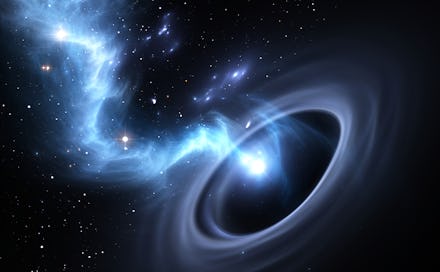Black hole sun: Thousands of planets could be forming around black holes

Black holes are weird. From the potential "spaghettification" of anything that might be unfortunate enough to be sucked into one to the odd activity that almost always surrounds them, there's a lot we still don't understand about these intergalactic anomalies. The most recent finding that has astrophysicists intrigued is a new piece of information published in a study authored by Keiichi Wada and a team of researchers at Japan's Kagoshima University. It appears that thousands of planets could be forming and orbiting around enormous black holes.
"Planets are not only orbiting around stars, but also around supermassive black holes," explained Wada in an interview with Space.com.
The "supermassive black holes" Wada is referring to include the enormous one found right at the center of our galaxy, which researchers believe is extremely powerful. Scientists believe, according to recent findings in the Astrophysical Journal, that it could in fact be responsible for a massive explosion that's believed to have happened around 3.5 million years ago.
The formation of new stars involves a kerfuffle of clouds of gas and dust, usually what's floating around the newborn stars to begin with. The clouds form disks, which lay the foundations of new planets known as "protoplanetary disks." Gravity then goes to work, pulling matter into larger masses. However, stars aren't the only bodies in the sky to find themselves surrounded by said disks. They also very often surround supermassive black holes. Because the phenomenon isn't localized to stars, Wada decided to investigate alongside his colleagues whether planets could be forming from said disks, even around black holes.
"I don't remember when and how I came up with this extreme idea, but maybe it is because I'm in a dusty environment — that is, given volcanic ash from the most active volcano in Japan, Sakurajima Mountain in Kagoshima," said Wada in the same interview with Space.com.
Wada and his team spent time studying galactic nuclei, or supermassive black holes that have begun devouring everything around them. This massive show of force has resulted in the holes creating ring-shaped areas of dust and gas around them which can stretch from 0.3 to 30 light-years away from the black hole. Wada and his colleagues discovered that planets can indeed form around these galactic nuclei.
"Common sense says planets are formed from protoplanetary disks around stars, but we found that planets could be also formed without the help of stars," explained Wada "They can be directly formed from dust grains around supermassive black holes." The team put together special computer models to study the way this process could occur. The planets that form as a result could be around 10 times the Earth's mass, ranging from massive ice balls to mostly-uninhabitable spheres of rock.
It's estimated that there could be over 10,000 planets orbiting active galactic nuclei, including the Milky Way's massive aforementioned supermassive black hole. Of course, the planets wouldn't be close enough to be affected by time dilation or any of the other bizarre effects the celestial bodies can have on other types of mass.
Now that the team has discovered the possibility of these planets, they'll be looking into investigating their evolution over time. It's going to be challenging, but Wada and his colleagues are looking to figure out if interactions with gravity could eventually cause these new planets to eventually move away from the black holes around which they formed.
You can file all of this under "yet another black hole mystery we've yet to completely solve."